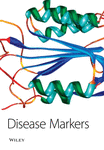Characterization of Plasma Membrane Proteins from Ovarian Cancer Cells Using Mass Spectrometry
Abstract
To determine how the repertoire of plasma membrane proteins change with disease state, specifically related to cancer, several methods for preparation of plasma membrane proteins were evaluated. Cultured cells derived from stage IV ovarian tumors were grown to 90% confluence and harvested in buffer containing CHAPS detergent. This preparation was centrifuged at low speed to remove insoluble cellular debris resulting in a crude homogenate. Glycosylated proteins in the crude homogenate were selectively enriched using lectin affinity chromatography. The crude homogenate and the lectin purified sample were prepared for mass spectrometric evaluation. The general procedure for protein identification began with trypsin digestion of protein fractions followed by separation by reversed phase liquid chromatography that was coupled directly to a conventional tandem mass spectrometer (i.e. LCQ ion trap). Mass and fragmentation data for the peptides were searched against a human proteome data base using the informatics program SEQUEST. Using this procedure 398 proteins were identified with high confidence, including receptors, membrane-associated ligands, proteases, phosphatases, as well as structural and adhesion proteins. Results indicate that lectin chromatography provides a select subset of proteins and that the number and quality of the identifications improve as does the confidence of the protein identifications for this subset. These results represent the first step in development of methods to separate and successfully identify plasma membrane proteins from advanced ovarian cancer cells. Further characterization of plasma membrane proteins will contribute to our understanding of the mechanisms underlying progression of this deadly disease and may lead to new targeted interventions as well as new biomarkers for diagnosis.




